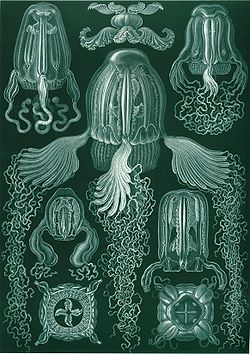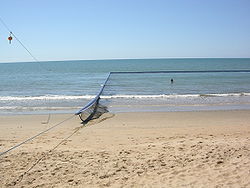
Box jellyfish
Background to the schools Wikipedia
SOS Children, an education charity, organised this selection. All children available for child sponsorship from SOS Children are looked after in a family home by the charity. Read more...
| Box Jellyfish | |
|---|---|
 |
|
| "Cubomedusae", from Ernst Haeckel's Kunstformen der Natur, 1904 | |
| Scientific classification | |
| Kingdom: | Animalia |
| Phylum: | Cnidaria |
| Class: | Cubozoa Werner, 1975 |
| Order: | Cubomedusae Haeckel 1877 |
| Families | |
|
see text |
|
Box jellyfish are invertebrates belonging to the class Cubozoa, named for their cube-shaped medusae. The Cubozoans are categorized separately from other types of jellyfish, and are considered more evolved; Scyphozoans. Likewise, the best-known species of box jellyfish, Chironex fleckeri, while sometimes simply called "the Box Jellyfish", is only one of a category which actually contains about 19 different species. The name sea wasp is also applied to some species of cubozoans, including the afterforementioned Chironex fleckeri and Carybdea alata. Box jellies can be found in Australia, the Philippines, Hawaii, Vietnam, and many other tropical areas. Box jellyfish are extremely venomous and can kill humans.
Box jellyfish are best known for the extremely powerful venom possessed by some of their species. The Chironex fleckeri and the Carukia barnesi ( Irukandji) species are the most venomous creatures in the world. Stings from such species are excruciatingly painful, either initially or as an after-effect, and are often fatal. However not all species of Box Jellyfish are this dangerous to humans.
Defence and feeding mechanisms
Box jellies use powerful venom contained in epidermic nematocysts, a structure exclusive to stinging cnidarians, to stun or kill their prey prior to ingestion, or as an instrument for defense. Their venom is the most deadly in the animal kingdom and has caused at least 5,567 recorded deaths since 1954. Most often, these fatal envenomations are perpetrated by the largest species of box jelly, Chironex fleckeri, owing to its high concentration of nematocysts, though at least two deaths in Australia have been attributed to the thumbnail-sized irukandji jellyfish (Carukia barnesi). Those who fall victim to Carukia barnesi suffer several severe symptoms known as Irukandji syndrome.
The venom of cubozoans is very distinct from that of scyphozoans, and is used to catch prey (fish and small invertebrates) and for defense from predators. Sea turtles, however, are apparently unaffected by the sting and eat box jellies.The season the box jellyfish come out is between October to April.
Box jellyfish are abundant in the warm waters of northern Australia and drive away most swimmers. However, they generally disappear during the Australian Winter. Australian researchers have used ultrasonic tagging to learn that these creatures sleep on the ocean floor between 3 am and dawn. It is believed that they sleep to conserve energy and to avoid predators.
Vision
Some theorize box jellyfish actively hunt their prey—for effective hunting they move extremely quickly (at speeds up to 3 to 3.5 knots (1.5 to 1.8 m/s)) instead of drifting as do true jellyfish. They are known to be the only jellyfish with an active visual system, consisting of 24 eyes located on the centre of each side of its bell.
The eyes occur in clusters on the four sides of the cube-like body. Sixteen are simply pits of light-sensitive pigment (eight slit-shaped eyes and eight lens-less pit eyes), but one pair in each cluster is surprisingly complex, with a sophisticated lens, retina, iris and cornea, all in an eye only 0.1 millimeters across.
The lenses on these eyes have been analyzed and could form distortion free images. Despite the perfection of the lenses, the retinas of the eyes lie closer to the lens than the optimum focal distance, resulting in a blurred image. One of these eyes in each set has an iris that contracts in bright light. Four of the eyes can only make out simple light levels.
It is not currently known how this visual information is processed by Cubozoa, as they lack a central nervous system, although they seem to have four brain-like organs. Some scientists have proposed that jellies have a “nerve net” that would allow the processing of visual cues.
Treatment of stings
First aid
If swimming at a beach where box jellies are known to be present, a bottle of vinegar is an extremely useful addition to the first aid kit. Following a sting, vinegar should be applied for a minimum of 30 seconds. Acetic acid, found in vinegar, disables the box jelly's nematocysts that have not yet discharged into the bloodstream (though it will not alleviate the pain). Vinegar may also be applied to adherent tentacles, which should then be removed immediately; this should be done with the use of a towel or glove to avoid bringing the tentacles into further contact with the skin. These tentacles will still sting if separate from the bell, or if the creature is dead. Removing the tentacles without first applying vinegar may cause unfired nematocysts to come into contact with the skin and fire, resulting in a greater degree of envenomation. If no vinegar is available, a heat pack has been proven for moderate pain relief. However, careful removal of the tentacles by hand is recommended. Vinegar has helped save dozens of lives on Australian beaches. Although commonly recommended in folklore and even some papers on sting treatment, there is no scientific evidence that urine, ammonia, meat tenderizer, sodium bicarbonate, boric acid, lemon juice, freshwater, steroid cream, alcohol, coldpack or papaya will disable further stinging, and these substances may even hasten the release of venom. Pressure immobilization bandages, methylated spirits, or vodka should never be used for jelly stings. Often in severe Chironex fleckeri stings cardiac arrest occurs quickly, so Cardiopulmonary resuscitation (CPR) can be life saving and takes priority over all other treatment options (including application of vinegar). Activate the emergency medical system for immediate transport to the hospital.
Classification
There are two families of Cubozoas, Chirodropidae and Carybdeidae, containing 19 species between them. Box Jellyfish of the Chirodropidae family, which contains the Chironex fleckeri species, are distinguished by being larger than those of Carybeidae and having numerous tentacles trailing from the corners of their bells. Carybdeidae, which contains the Irukandji species, are smaller, and only have a single tentacle trailing from each corner of their bells. A phylogenic analysis of the relationships between these two families is yet to be published.
- Phylum Cnidaria
- Family Chirodropidae
- Chironex fleckeri
- Chirosoides buitendijkl
- Chirodropus gorilla
- Chirodropus palmatus
- Chiropsalmus zygonema
- Chiropsalmus quadrigatus
- Chiropsalmus quadrumanus
- Family Carybdeidae
- Carukia barnesi
- Manokia stiasnyi
- Tripedalia binata
- Tripedalia cystophora
- Tamoya haplonema
- Tamoya gargantua
- Carybdea alata
- Carybdea xaymacana
- Carybdea sivicksi
- Carybdea rastonii
- Carybdea marsupialis
- Carybdea aurifera

